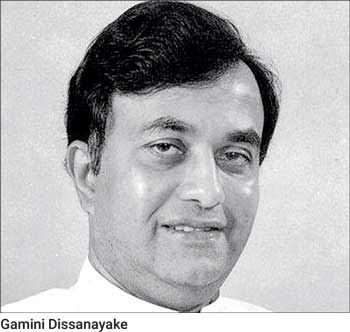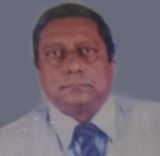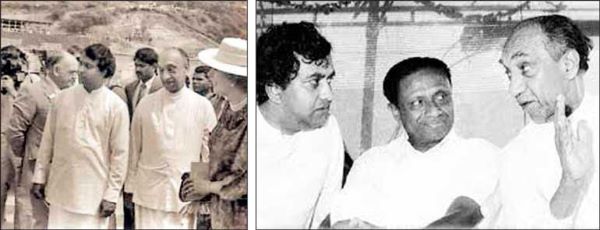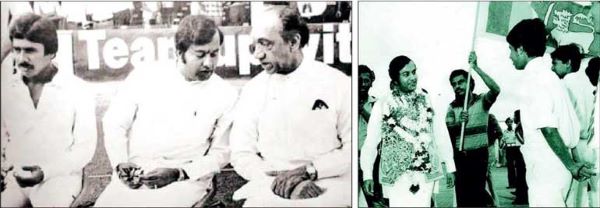Gamini Dissanayake, a supreme politician – by Sunil Thenabandu

 As a young and energetic politician and the people’s representative in the Nuwara Eliya District, Gamini Dissanayake extended yeoman service to all constituents with devotion, obligation and absolute dedication using his characteristic charismatic loom, irrespective of caste, creed and religion, despite of each person’s political affiliations.
As a young and energetic politician and the people’s representative in the Nuwara Eliya District, Gamini Dissanayake extended yeoman service to all constituents with devotion, obligation and absolute dedication using his characteristic charismatic loom, irrespective of caste, creed and religion, despite of each person’s political affiliations.
It would be tricky to find a single politician in the archives of history of the Democratic Socialist Republic of Sri Lanka who was as vastly commended and held in sky-scraping esteem by his contemporaries and so cherished by his political opponents, predominantly due to his impartial and unbiased mindset principally owed to his unprejudiced stance.
He was a unique and extraordinary politician who listened to the masses, solved their problems, and touched their lives in a very affirmative and compassionate mode. Anyone who was eager to meet him had very uncomplicated access, irrespective of their political affiliations.
He never resorted in pity, insignificant, diverse, and partisan politics. He was eternally enthusiastic to have sensible debates. He possessed a very comprehensible, self-motivated dynamic vision and had no intention in making false and hollow promises. His humility and friendly disposition endeared him to magnetise a large cross section of friends. He never differentiated between the rich and the poor and his hospitality to a poor and rich person was comparable. He listened to the masses, solved their evils.
Accelerated Mahaweli Program
Much has been already printed about Gamini Dissanayake and his contributions to national progress and sports, cricket in particular an significantly, his accomplishment of what came to be called as the Accelerated Mahaweli Program which he spearheaded by completing it within a short span of six years what had been premeditated for 30 long years.
The day 24 October 2021 denotes the 27th death anniversary of charismatic, captivating and superlative politician Gamini Dissanayake who was cruelly killed by a LTTE female suicide bomber on the night of 24 October 1994, in Thotalanga along with many UNP stalwarts who were canvassing a last ditch campaign for his own presidential race.
The news of his tragic death sparked instantly islandwide and also worldwide, shattered all hopes and thwarted people’s dream and aspirations of their charismatic and caring leader becoming the President of the country which otherwise was inevitable, with the Presidential Election just two weeks away. It was an irreparable rout to the entire nation, as during his 24-year tenure of service in dynamic affairs of State, he had achieved more than a lifetime’s worth of milestones, goals and accomplishments, much perhaps more than any other politician had achieved in the annals of politics in the country, inside such a relatively miniature span in politics.
From the attack which killed him instantaneously, he had not sustained wounds but only two little holes on his forehead and chest which were found on his dead body caused by the pellets of the powerful bomber. The potential president to be had been assassinated ruthlessly along with several UNP bigwigs. It was a devastation of an almost an integral part of the UNP elite community.
On this momentous day the family members of the Gamini Dissanayake had joined the ranks of over 50,000 other families who had lost very precious lives in these hollow racial hostilities that were fought.
Unprejudiced stance
At the raw age of 28 he had begun a practice as a lawyer working in Neville Samarakoon’s Chambers who was later appointed as the Chief Justice. The then Prime Minister Dudley Senanayake had courageously amid self-confidence opted him to compete in the Nuwara Eliya seat although those of the UNP high command then including the Deputy Leader, J.R. Jayewardene, were not content with the option.
The sitting member then was Donald Ranaweera, a wealthy proprietary planter, an imperative financier of the party, and also the then Chairman of the Times Group of Newspapers. On Gamini Dissanayake’s nomination, Donald Ranaweera much to the embarrassment of the UNP contested in the adjoining Maskeliya seat as an Independent candidate. Donald Ranaweera in anger to take revenge had spent his ‘money strength’ just to thwart his ballot votes in Nuwara Eliya.
The Nuwara Eliya campaign of May 1970 and the by-election that followed in October 1972 as a result of Gamini Dissanayake being unseated via an election petition were the toughest political campaigns faced as he only was a novice and his first foray in politics having commenced a career as a lawyer. In the May 1970 with the exception for the blessings of the then Prime Minister Dudley Senanayake he had only a diminutive grasp from the party hierarchy. He was nicknamed as a “Parachute Karaya” as his father Andrew Dissanayake was an ex-MP of Nuwara-Eliya over two decades earlier under a SLFP regime of S.W.R.D. Bandaranaike.
As a young and energetic politician and the people’s representative in the Nuwara Eliya District, he extended yeoman service to all constituents with devotion, obligation and absolute dedication using his characteristic charismatic loom, irrespective of caste, creed and religion, despite of each person’s political affiliations. It would be tricky to find one more solitary politician in the archives of history of the Democratic Socialist Republic of Sri Lanka, who was so vastly commended and held in sky-scraping esteem by his contemporaries and so cherished by his political opponents, predominantly due to his impartial and unbiased mind-set principally owed to his unprejudiced stance.

Excellent orator
When one reminisces about Gamini Dissanayake, just a handful would rebuff that he was very much cherished, accepted and admired. With his in-born charisma, his well-behaved and transmittable grin, his aptitude to paddle a person on his shoulders as if he knew him well and his knack of saying things which positioned people at easiness, made him an appealing outgoing person. He was real gentleman, a living icon by people orientation and a doyen in the political arena. The chemistry between him and his public was never more evident than in the collective reaching out of people from upcountry villages and tea plantations; from Mahaweli homesteads and Swarnabhoomi lands.
He was an excellent orator who spoke sense, retaining all audiences spellbound. The contents of his speeches spelt out his promises, inspiring the desperate with hope for their lives. The firm foundation built and the confidence gained by the people of the electorate, in particular, helped in his stride to nurture and mature into an ideal politician.
When the United National Party came into power in the year 1977, he was entrusted with many ministerial portfolios, monumental goals, and tasks during the tenure of the Government. The ministerial portfolios entrusted to him were Irrigation, Power, Construction, Lands, Land Development, Mahaweli, Plantation Industries and Highways.
The late Gamimi Dissanayake had once confessed that the word ‘development’ meant developing of infrastructure such as roads, industrial factories, schools, playgrounds, transport, the end result of ‘development’ is upliftment of the livelihood, ethics of the masses in physical, mental, moral, social, and cultural advancement.
The most gigantic task he confronted was, of course, the historical accelerated Mahaweli Project. The toughest challenge in its implementation was the evacuation of approximately 3,000 families from over 50 villages, who lived in the valley of the Kotmale reservoir. This also included about 15 places of religious worship. The late leader too sacrificed his own ancestral lands. Those villagers were forced to leave their traditional homes to breathe in foreign environments.
The Kotmale reservoir was one among other reservoirs, Victoria, Randenigala, Rantembe, Ulhitiya, Rahkinda and Maduruoya, which were built and commissioned under the accelerated Mahaweli development programme. This multipurpose diversion scheme also included the amalgamation of several canals and waterways. This gigantic Mahaweli scheme, with foreign collaboration, was manned by proficient personnel deployed both locally and internationally, using innovative and pioneering technology under the close scrutiny of the giant leader.
The gigantic exercise was initially targeted to be completed in 30 years. However, due to his enormous skill, the charismatic approach and untiring leadership, it was completed in an unbelievably short period of just seven years The Kotmale reservoir was commissioned on 24 August 1985, fulfilling a dream of the late Gamini Dissanayake. Those who sacrificed lands have now settled and are living freely and independently, having had their basic needs fulfilled like jobs, shelter and food, while making maximum use of the golden waters of the reservoirs for their agricultural needs.
The speech he delivered on that day was emotional and fascinating. While paying great tribute to those who sacrificed lands engulfed in the reservoir, he emphasised that it was made in the national interest with a vision towards an unambiguous development revolution. He said, “I believe the agony and the pain of mind the people of Kotmale and my relatives suffered as a result of the loss of ancestral lands; will be compensated when they witness the vast benefits that this project will fetch to the next generation.”

Gamini Dissanayake Reservoir
As a gesture of national gratitude, on 11 April 2003 the ‘Kotmale Reservoir’ was appropriately renamed as the ‘Gamini Dissanayake Reservoir’ by unveiling his statue at a glittering ceremony presided over by the then Prime Minister Ranil Wickremesinghe with the participation of Cabinet Ministers, VIPs, Srima Dissanayake, Chairperson of the Gamini Dissanayake Foundation, Navin Dissanayake, Director of the Gamini Dissanayake Foundation, and the then Minister of Investment Promotion and other distinguished invitees.
This event became more significant as it took place at a time when the farmers were blessed with a bumper paddy harvest that they had been deprived of for a stretched phase of time. This made a tremendous impact on the economic revival of the country.
Besides being actively engaged in our development process, he found the time to be enthusiastically involved in the game of cricket; having held office as the President of the Board of Control of Cricket in Sri Lanka, BCCSL (now known as Sri Lanka Cricket) from June 1981 to June 1989 and thereafter, for a brief period of four months, immediately prior to his tragic death in 1994; during which period he made many significant contributions.
During the tenure of past Presidents of the then BCCSL, Robert Senanayake, held office for 17 years, T.B. Werapitiya and General B.R. Heyn who held office for comparatively shorter periods, made the utmost gentle persuasive efforts to the relentless International Cricket Council (ICC), the governing body of world cricket, to qualify us as full members of the ICC to play Test cricket.
ICC Test status
The labours of his predecessors were not given any compassion but proved futile year after year. It was England and Australia who had the joint rejection power, who stood against flanking us. They were absolutely liable in spiralling down our frantic pursuit for full membership of the ICC.
The then President of the Pakistani Cricket Board Abdul Hafeez Karder made valiant labours towards our laudable reason and, in vertical intense anxiety, accused the ICC of ethnic discrimination in the year 1975. It was the suggestion of our then late BCCSL President to form the Asian Cricket Council along with India, to counteract the white supremacy of the ICC. It was beside this bleak environment that he was persuaded to acknowledge the post of President. However, for him, no task or goal was impossible. He altered the then existed infrastructure, which remained untouched for years. He placed new trends and values in conducting the behaviour of the then board. He inaugurated the Sri Lanka Cricket Foundation and was adamant that at any cost he was obtaining us full ICC Test status with full membership.
He then embarked on a program of exertion with a visualisation to achieve what he felt was preeminent for Sri Lankan cricket. This included the construction of a building to house the headquarters of cricket at Maitland Place, construction of modern indoor net facilities, development of the Asgiriya stadium and other grounds at provincial venues to play International and domestic cricket, inaugurated a programme to send young cricketers for training overseas, launched a cricketers’ benevolent fund and commenced intensive teaching for umpires, coaches, and curators, etc.
He was similarly an impeccable orator in English. The mode in which he proved our eligibility for full membership at the ICC meeting at Lords in 1981 held the audience spellbound. Ultimately, Sri Lanka was finally elected as a full member of the ICC.
This achievement was even more remarkable in the context that he held office as the President of the then Board, only for a couple of months The ICC knew very well that we were eligible to enter the elite. But they meted out step-motherly treatment to us. After all the spadework, it was very unfortunate that he could not live until 1996, when Sri Lanka won the plum of world cricket, the Wills Word Cup in 1996, only 17 months after his tragic demise.
May he attain supreme bliss of Nirvana!
(For those of us who stood with him, he was open, generous, hospitable and a pleasure to work with).
(The writer, now based in Brisbane, knew both the late Minister and his wife late Sirima personally for a long time and had also canvassed for his by-election in Nuwara Eliya in 1972 having been posted to Bank of Ceylon then. He can be reached via sthenabadu@hotmail.co







